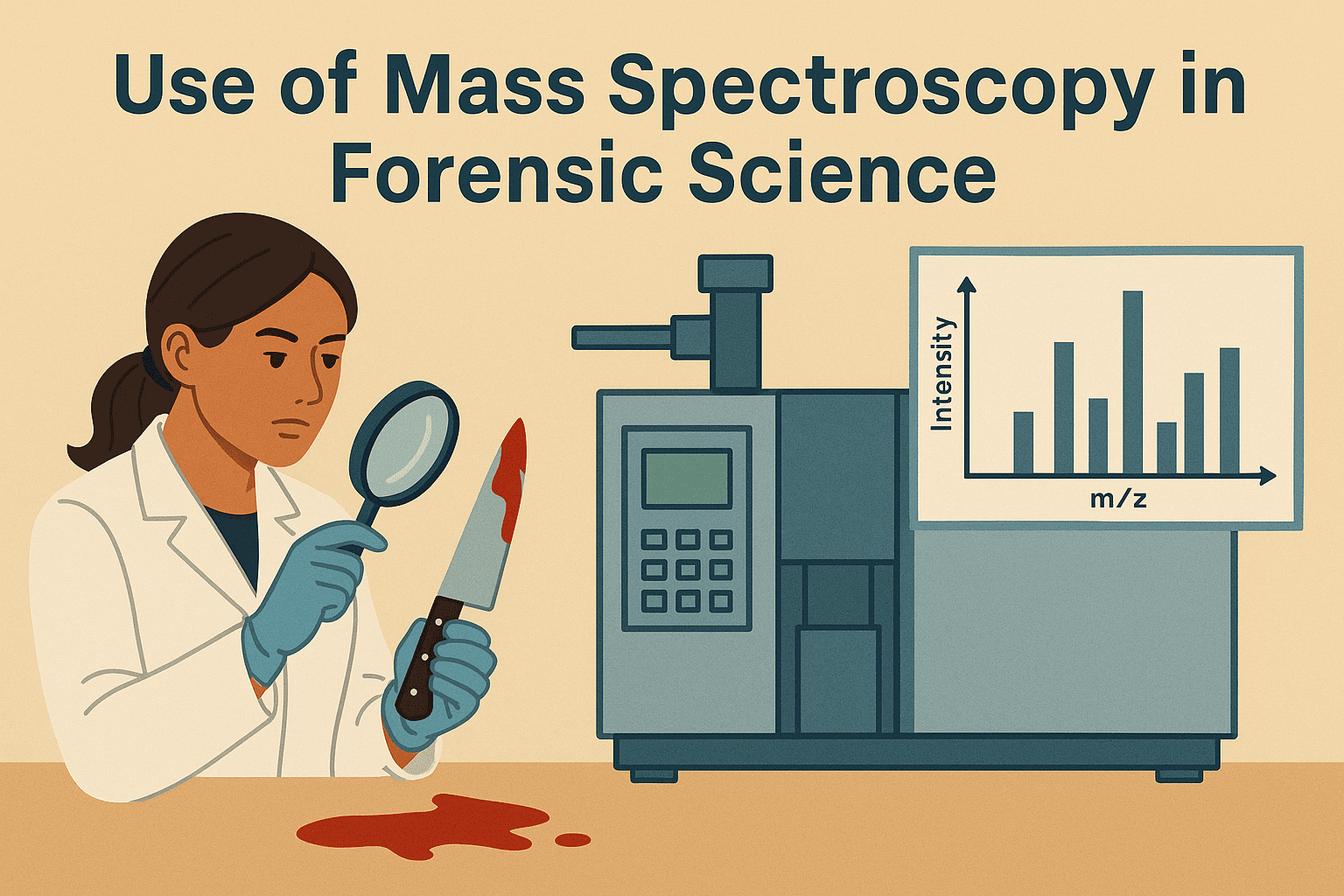Mass Spectroscopy is widely used tool in the field of Analytical chemistry. This tool is used to determine the exact molecular weight of the any analyte.
Principle of Mass Spectroscopy
Mass spectrometry (MS) is an analytical technique used to determine the molecular weight and structure of a compound by measuring the mass-to-charge ratio (m/z) of its ions.
Applications:
- Determination of molecular weight
- Structural elucidation of compounds
- Identification of unknown compounds
- Quantitative analysis of complex mixtures
Forensic science is branch of science which help to solve crimes. It includes collecting and examining evidence at a crime scene, such as fingerprints, hair, blood, or a bit of clothing. Forensic scientists employ biology, chemistry, and physics tools to see what occurred. For instance, they can identify a person through fingerprints or DNA, or determine the type of poison that was used. They also examine items such as handwriting, guns, or computer and telephone data.
This science helps the police to solve the crime by providing the scientific evidence. Forensic science contributes to a great extent towards justice. It is being a living detective with the help of science!
Forensic science is a use of science to investigate crime and present unbiased scientific evident in court.
Fig: 1 Area of Forensic science department.
Introduction
Now-a-days identification and quantification of drugs of abuse are the
most concerning issues in the forensic science. The amount of the intake of such narcotics is also important. The Occurrence of drug addiction and abuse in the population worldwide is significantly soaring resulting in one of the main grounds of high criminal activities.
The excessive use of psychotropic substances, natural drugs, hallucinogens, and most recently novel narcotic agents and new psychoactive substances are the preliminary cause for drug addiction and resulting high rates of crime in the present scenario.
Mass spectroscopy, also termed as mass spectrometry, is a scientific technique that analyzes a sample of material to determine its molecular structure. In this method minute amount of the sample is ionized and then the spectrum of it is been obtained through mass spectrometer. Through the obtained spectrum researcher analyze and categorize those ions to thorough investigation analyst can determine the sample’s composition of unknown substance. Thus Mass spectroscopy becomes vital tool for the forensic sample analysis. It can be utilized in Toxicology Analysis, Trace Evidence, Arson Investigations, Explosive Residue analysis.
Fig: 2 Block diagram of Mass Spectrometer
Toxicology Analysis
The extensive use of toxic substances in Agriculture leads to distribution of such substances in our ecological system. Use of such contaminated food can be detrimental for the human beings. Some narcotics substances when taken up in excess amount can also results in death. In cases involving poisons or toxins. Forensic analysts can take samples of a subject’s tissues or bodily fluids and determine if any toxic substances are present. Concentration of the poison can also been detected by use of Mass spectroscopy. This can give vital clues to investigators as to how a victim died as well as help identify the time and dosage of any poison or medication ingested. Investigators can also determine if a victim was a regular user of any substances that might have contributed.
Trace Evidence
Mass spectrometry is also important in analyzing trace evidence. Investigators at a crime scene may find microscopic materials like carpet fibers, glass splinters or paint flakes. Ordinarily, these substances might be extremely difficult to use as a starting point to identify a suspect. By using Mass spectrometer one can determine the precise mix of dyes used in carpet fibers, the makeup of materials that went into any particular glass fragment and the precise set of polymers present in any paint sample. This information manufacturer, and narrow down where a given sample came from, helping detectives to identify suspects and build a case.
Arson Investigations
Arson investigations can also benefit from the use of mass spectrometry. While an arson investigator might be able to identify the use of an accelerant through burn patterns or lingering odors, a mass spectrometer can break down any residue and provide an accurate report of its molecular makeup. This can help identify any unique or exotic compounds that may be present. Discovering a similar mix used at multiple crime scenes may be useful for identifying the work of a serial arsonist.
Explosive Residue
Another area where spectrographic analysis is extremely useful is in analyzing explosive residue. When a bomb detonates, it may not leave behind much in the way of physical evidence — perhaps only small fragments and chemical residues. However, commercial explosive manufacturers each utilize their own unique mix of chemicals, and a spectrometer can analyze this residue to identify the particular makeup of the explosive involved. Even in cases where a bomber used a homemade mix, the analysis may identify the type of materials used and give investigators a push in the right direction to identify the source.
Other Uses of mass spectroscopy.
- Determination of molecular weight
- Structural elucidation of organic compounds
- Identification of unknown compounds
- Quantitative analysis of mixtures
- Detection of impurities in drugs and chemicals
- Pharmacokinetic and metabolic studies
- Analysis of proteins and peptides (Proteomics)
- DNA/RNA analysis (Genomics)
- Detection of drug metabolites in biological samples
- Environmental monitoring (pollutant detection)
- Forensic investigations and toxicology
- Food safety and quality control
- Isotope ratio analysis and elemental composition
- Characterization of polymers and materials
- Clinical diagnostics and biomarker discovery
References
1. H. Rajput,(2024). Biological Evidence For Crime Investigation. Journal of Digital Security and
Forensics, 1(1), 34–52.
2. https://www.philstar.com/headlines/2018/03/27/1797029/how-forensic-science-making-
breakthrough-philippines.
3. C. Moore, L. Marinetti, C. Coulter, and K. Crompton, “Analysis of pain management drugs,
specifically fentanyl, in hair: application to forensic specimens,” Forensic Science International,.
vol. 176, no. 1, pp. 47–50, 2008.
4. N. G. S Mogollo´n, C. D. Q-Moreno, P.S. Prata, J. R. de Almeida, A. S. Cevallos, R. Torres-
Guie´rrez, F. Augusto, “New Advances in Toxicological Forensic Analysis Using Mass
Spectrometry Techniques” Journal of Analytical Methods in Chemistry Volume 2018, no- 1, pp
1-17.
5. J Xiong, B-F Yuan, Y.Q. Feng, “Mass Spectrometry for Investigating the Effects of Toxic
Metals on Nucleic Acid Modifications” Chem. Res. Toxicol. 2019, 32, 5, 808-819.
6. Gaillard, Y., & Pepin, G. (1999). Poisoning by plant material: review of human cases and
analytical determination of main toxins by high-performance liquid chromatography–(tandem)
mass spectrometry. Journal of Chromatography B: Biomedical Sciences and
Applications, 733(1-2), 181-229.
– Dr. Jigar Y. Soni
Dean, Faculty of Basic & Applied Sciences, Madhav University, Pindwara, Sirohi, Rajasthan

